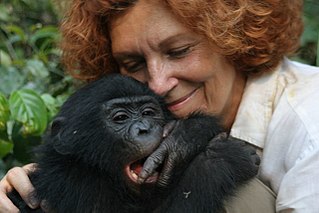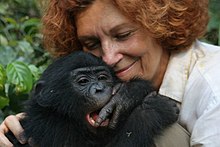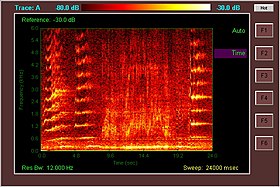
Washoe was a female common chimpanzee who was the first non-human to learn to communicate using American Sign Language (ASL) as part of an animal research experiment on animal language acquisition.

Cetacean intelligence is the overall intelligence and derived cognitive ability of aquatic mammals belonging in the infraorder Cetacea (cetaceans), including baleen whales, porpoises, and dolphins. In 2014, a study found for first time that the long-finned pilot whale has more neocortical neurons than any other mammal, including humans, examined to date.
Yerkish is an artificial language developed for use by non-human primates. It employs a keyboard whose keys contain lexigrams, symbols corresponding to objects or ideas.

Animal cognition encompasses the mental capacities of non-human animals including insect cognition. The study of animal conditioning and learning used in this field was developed from comparative psychology. It has also been strongly influenced by research in ethology, behavioral ecology, and evolutionary psychology; the alternative name cognitive ethology is sometimes used. Many behaviors associated with the term animal intelligence are also subsumed within animal cognition.

Animal communication is the transfer of information from one or a group of animals to one or more other animals that affects the current or future behavior of the receivers. Information may be sent intentionally, as in a courtship display, or unintentionally, as in the transfer of scent from predator to prey with kairomones. Information may be transferred to an "audience" of several receivers. Animal communication is a rapidly growing area of study in disciplines including animal behavior, sociology, neurology and animal cognition. Many aspects of animal behavior, such as symbolic name use, emotional expression, learning and sexual behavior, are being understood in new ways.

Kanzi, also known by the lexigram , is a male bonobo who has been the subject of several studies on great ape language. According to Sue Savage-Rumbaugh, a primatologist who has studied the bonobo throughout his life, Kanzi has exhibited advanced linguistic aptitude.

Research into great ape language has involved teaching chimpanzees, bonobos, gorillas and orangutans to communicate with humans and each other using sign language, physical tokens, lexigrams, and imitative human speech. Some primatologists argue that the use of these communication methods indicate primate "language" ability, though this depends on one's definition of language. The cognitive tradeoff hypothesis suggests that human language skills evolved at the expense of the short-term and working memory capabilities observed in other hominids.

The mirror test—sometimes called the mark test, mirror self-recognition (MSR) test, red spot technique, or rouge test—is a behavioral technique developed in 1970 by American psychologist Gordon Gallup Jr. as an attempt to determine whether an animal possesses the ability of visual self-recognition. The MSR test is the traditional method for attempting to measure physiological and cognitive self-awareness. However, agreement has been reached that animals can be self-aware in ways not measured by the mirror test, such as distinguishing between their own and others' songs and scents, and being aware of their own bodies, while humans have abnormally good vision, and thus intelligence that is highly visual.
The Mind of an Ape is a 1983 book by David Premack and his wife Ann James Premack. The authors argue that it is possible to teach language to (non-human) great apes. They write: "We now know that someone who comprehends speech must know language, even if he or she cannot produce it."

Human–animal communication is the communication observed between humans and other animals, ranging from non-verbal cues and vocalizations to the use of language.
Animal culture can be defined as the ability of non-human animals to learn and transmit behaviors through processes of social or cultural learning. Culture is increasingly seen as a process, involving the social transmittance of behavior among peers and between generations. It can involve the transmission of novel behaviors or regional variations that are independent of genetic or ecological factors.

Elephant cognition is animal cognition as present in elephants. Most contemporary ethologists view the elephant as one of the world's most intelligent animals. With a mass of just over 5 kg (11 lb), an elephant's brain has more mass than that of any other land animal, and although the largest whales have body masses twenty times those of a typical elephant, a whale's brain is barely twice the mass of an elephant's brain. In addition, elephants have around 257 billion neurons. Elephant brains are similar to those of humans and many other mammals in terms of general connectivity and functional areas, with several unique structural differences. Although initially estimated to have as many neurons as a human brain, the elephant's brain has about three times the amount of neurons as a human brain. However, the elephant's cerebral cortex has about one-third of the number of neurons as a human's cerebral cortex.
Vocal learning is the ability to modify acoustic and syntactic sounds, acquire new sounds via imitation, and produce vocalizations. "Vocalizations" in this case refers only to sounds generated by the vocal organ as opposed to by the lips, teeth, and tongue, which require substantially less motor control. A rare trait, vocal learning is a critical substrate for spoken language and has only been detected in eight animal groups despite the wide array of vocalizing species; these include humans, bats, cetaceans, pinnipeds, elephants, and three distantly related bird groups including songbirds, parrots, and hummingbirds. Vocal learning is distinct from auditory learning, or the ability to form memories of sounds heard, a relatively common trait which is present in all vertebrates tested. For example, dogs can be trained to understand the word "sit" even though the human word is not in its innate auditory repertoire. However, the dog cannot imitate and produce the word "sit" itself as vocal learners can.
A talking animal or speaking animal is any non-human animal that can produce sounds or gestures resembling those of a human language. Several species or groups of animals have developed forms of communication which superficially resemble verbal language, however, these usually are not considered a language because they lack one or more of the defining characteristics, e.g. grammar, syntax, recursion, and displacement. Researchers have been successful in teaching some animals to make gestures similar to sign language, although whether this should be considered a language has been disputed.

Primate cognition is the study of the intellectual and behavioral skills of non-human primates, particularly in the fields of psychology, behavioral biology, primatology, and anthropology.

Laughter in animals other than humans describes animal behavior which resembles human laughter.

Panbanisha, also known by the lexigram , was a female bonobo that featured in studies on great ape language by Professor Sue Savage-Rumbaugh. Her name is Swahili for "to cleave together for the purpose of contrast."

The cooperative pulling paradigm is an experimental design in which two or more animals pull rewards toward themselves via an apparatus that they cannot successfully operate alone. Researchers use cooperative pulling experiments to try to understand how cooperation works and how and when it may have evolved.
Panpanzee the chimpanzee, was born at the Language Research Center at Georgia State University in Atlanta, Georgia. She lived the rest of her life at the Great Ape Trust in Iowa. Her half-brother is Kanzi, a famous bonobo. Kanzi learned 348 lexigram symbols and over 3,000 words from the English language over her lifespan.

















